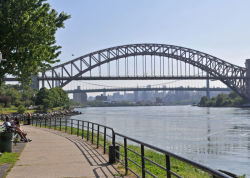Ralph Demarco Park
Ralph DeMarco Park
What was here before?
In 1652, this area was part of Newtown. Subsequently, it became part of the village of Astoria in 1839, of Long Island City in 1870, and finally of New York City in 1898. An original Native American trail between 20th and 21st Avenues led from Hell Gate to eastern Long Island. The trail, which was laid out as the Bowery Bay and Out Plantations Road in 1638-50, still lies under 20th Road. The Hell Gate was described in 1670 as “a narrow passage, [through which] there runneth as violent stream both upon flood and ebb, and in the middle lied some islands of rocks, which the current sets so violently upon, that it threatens present shipwreck.” It was formed by underground faults and contained some of the deepest water in New York Harbor, as well as treacherous reefs with such picturesque names as “Frying Pan,” “Mill Rock,” “The Gridiron,” and “Ways Reef.”
How did this site become a park?
In 1968, the Board of Estimate mapped the land as an addition to Astoria Park. The city had title to most of the upland but still needed to acquire several small private parcels. The new mapped area was an irregular, elongated strip of decrepit waterfront,1,790 feet in length and varying in width from 39 feet to about 244 feet, much of it still underwater. The New York City Transit Authority used the material excavated from the 63rd Street subway tunnel as landfill for the park, greatly reducing costs.
The park helped advance waterfront development and improvements to the surrounding area When the park opened, the city launched a $30 million rehabilitation project for Astoria Gardens, a complex of 1,438 apartments in 26 buildings, across from the park. It was the first major facelift for the complex since it was built in 1949 for war veterans. The arrangement of the narrow park, with paths, sitting areas, and weeping willows, provides a beautiful walk along the shore of the East River.
Who is this park named for?
Ralph Demarco (1908-1977), a community and political leader in Queens County, envisioned a park at this site and worked hard to turn his dream into reality. Demarco was born in Calabria, Italy, and immigrated to Astoria with his family when he was three years old. Demarco served as Deputy Commissioner of the Department of Sanitation and as an executive member of the Taminent Regular Democratic Club for 44 years. He was also the District Leader for 11 years. Convinced that an attractive waterfront would improve the quality of life for people in Astoria, he fought to make the East River a place to relax and enjoy the beautiful view of Manhattan.
Demarco died in 1977, never having seen the finished park which was dedicated on July 23, 1980.
Check out your park's Vital Signs
Clean & Safe
Green & Resilient
Empowered & Engaged Users
Share your feedback or learn more about how this park is part of a
Vital Park System

